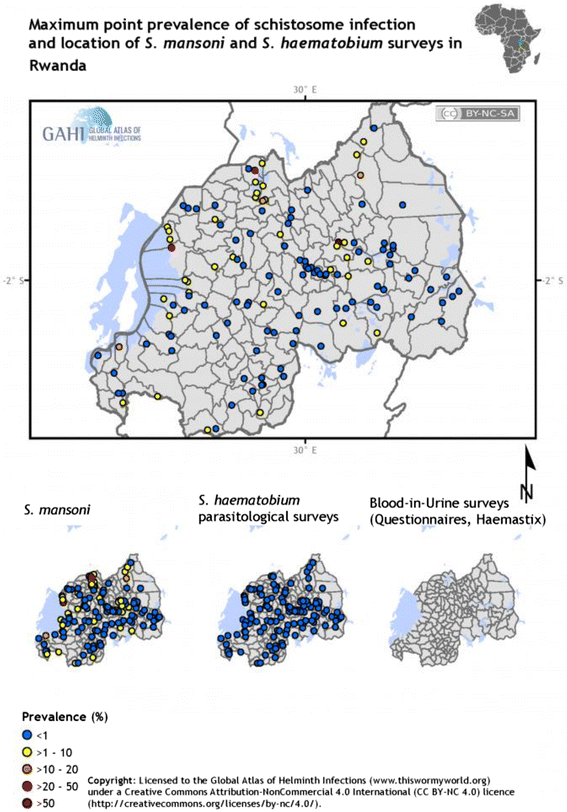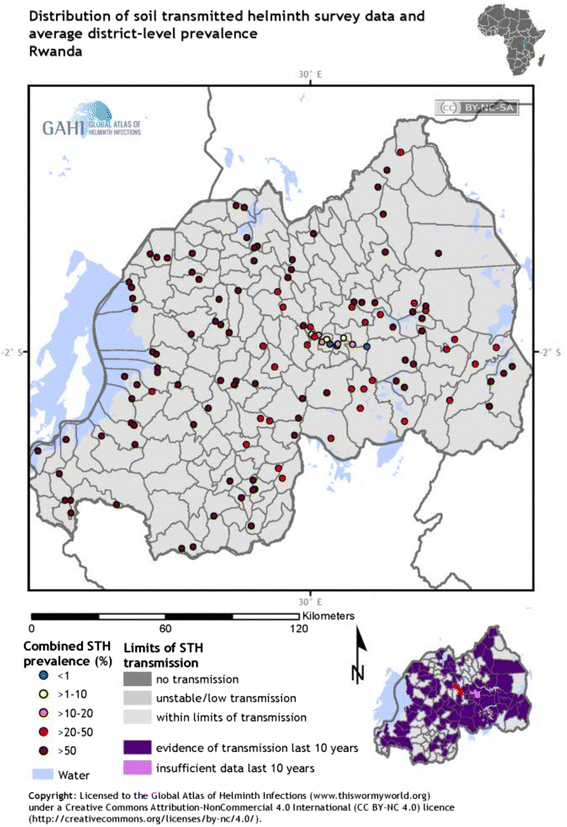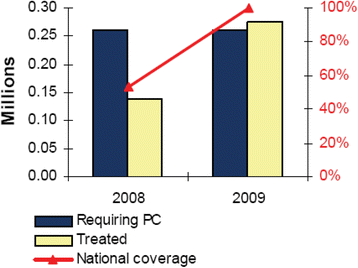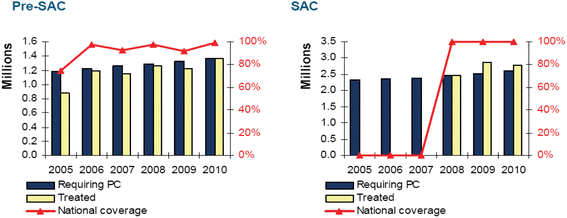Schistosomiasis and soil-transmitted helminthiasis in Rwanda: an update on their epidemiology and control
- PMID: 28245883
- PMCID: PMC5331630
- DOI: 10.1186/s40249-016-0212-z
Schistosomiasis and soil-transmitted helminthiasis in Rwanda: an update on their epidemiology and control
Abstract
Even though Rwanda lies within a region that has a high prevalence of schistosomiasis and soil-transmitted helminth (STH) infections, epidemiological information regarding these infections in the country remains scarce. The present review attempts to compile the available data on schistosomiasis and STHs, from 1940 to 2014, to provide an insight on the epidemiological profile of these infections. This information will, in turn, support the design and implementation of sustainable control measures. The available records indicate that only Schistosoma mansoni and all the major species of STHs are endemic in Rwanda. In 2008, the national prevalence of S. mansoni was reported to be 2.7%, ranging from 0 to 69.5%, and that of STH infections was 65.8% (diagnosed using the Kato-Katz technique). The prevalence of these infections varies from one district to another, with schoolchildren remaining a highly affected group. The main control approach is mass drug administration using albendazole and praziquantel, mostly targeting school-aged children in school environments. In 2008, adult individuals living in areas with a prevalence of S. mansoni ≥30% were also included in the mass drug administration programme. However, despite Rwanda achieving an almost 100% coverage of this programme in 2008-2010, the transmission of S. mansoni and STHs continues to take place, as illustrated by the most recent surveys. If Rwanda is to achieve sustainable control and elimination of schistosomiasis and STHs, there is a need to revise the country's control strategy and adopt an integrated control approach that involves a combination of measures.
Keywords: Control; Epidemiology; Rwanda; Schistosomiasis; Soil-transmitted helminths.
Figures




Similar articles
-
Prevalence of Schistosomes and Soil-Transmitted Helminths among Schoolchildren in Lake Victoria Basin, Tanzania.Korean J Parasitol. 2015 Oct;53(5):515-24. doi: 10.3347/kjp.2015.53.5.515. Epub 2015 Oct 29. Korean J Parasitol. 2015. PMID: 26537030 Free PMC article.
-
Integrated Schistosomiasis and Soil-Transmitted Helminthiasis Control over Five Years on Kome Island, Tanzania.Korean J Parasitol. 2015 Oct;53(5):535-43. doi: 10.3347/kjp.2015.53.5.535. Epub 2015 Oct 29. Korean J Parasitol. 2015. PMID: 26537032 Free PMC article.
-
High level of Schistosoma mansoni infection in pre-school children in Sierra Leone highlights the need in targeting this age group for praziquantel treatment.Acta Trop. 2012 Nov;124(2):120-5. doi: 10.1016/j.actatropica.2012.07.005. Epub 2012 Jul 20. Acta Trop. 2012. PMID: 22820025
-
Integrated control programmes for schistosomiasis and other helminth infections in P.R. China.Acta Trop. 2015 Jan;141(Pt B):332-41. doi: 10.1016/j.actatropica.2013.11.028. Epub 2013 Dec 17. Acta Trop. 2015. PMID: 24361182 Review.
-
Soil transmitted helminth infections and schistosomiasis in school age children in sub-Saharan Africa: efficacy of chemotherapeutic intervention since World Health Assembly Resolution 2001.Tanzan J Health Res. 2010 Jan;12(1):86-99. doi: 10.4314/thrb.v12i1.56366. Tanzan J Health Res. 2010. PMID: 20737834 Review.
Cited by
-
Malacological Survey and Spatial Distribution of Intermediate Host Snails in Schistosomiasis Endemic Districts of Rwanda.Trop Med Infect Dis. 2023 May 28;8(6):295. doi: 10.3390/tropicalmed8060295. Trop Med Infect Dis. 2023. PMID: 37368713 Free PMC article.
-
Using Routinely Collected Health Records to Identify the Fine-Resolution Spatial Patterns of Soil-Transmitted Helminth Infections in Rwanda.Trop Med Infect Dis. 2022 Aug 22;7(8):202. doi: 10.3390/tropicalmed7080202. Trop Med Infect Dis. 2022. PMID: 36006294 Free PMC article.
-
A scoping review of current practices on community engagement in rural East Africa: Recommendations for snakebite envenoming.Toxicon X. 2021 Jul 16;11:100073. doi: 10.1016/j.toxcx.2021.100073. eCollection 2021 Sep. Toxicon X. 2021. PMID: 34381992 Free PMC article.
-
Prevalence, Risk Factors, and Coinfection of Urogenital Schistosomiasis and Soil-Transmitted Helminthiasis among Primary School Children in Biase, Southern Nigeria.J Parasitol Res. 2021 Mar 13;2021:6618394. doi: 10.1155/2021/6618394. eCollection 2021. J Parasitol Res. 2021. PMID: 33791124 Free PMC article.
-
Mapping Schistosoma mansoni endemicity in Rwanda: a critical assessment of geographical disparities arising from circulating cathodic antigen versus Kato-Katz diagnostics.PLoS Negl Trop Dis. 2019 Sep 30;13(9):e0007723. doi: 10.1371/journal.pntd.0007723. eCollection 2019 Sep. PLoS Negl Trop Dis. 2019. PMID: 31568504 Free PMC article.
References
-
- Global Burden of Disease Study 2013 Collaborators Global, regional, and national incidence, prevalence, and years lived with disability for 301 acute and chronic diseases and injuries in 188 countries, 1990–2013: a systematic analysis for the Global Burden of Disease Study 2013. Lancet. 2015;386(9995):743–800. doi: 10.1016/S0140-6736(15)60692-4. - DOI - PMC - PubMed
Publication types
MeSH terms
Substances
LinkOut - more resources
Full Text Sources
Other Literature Sources

